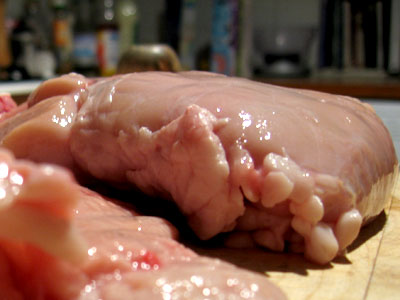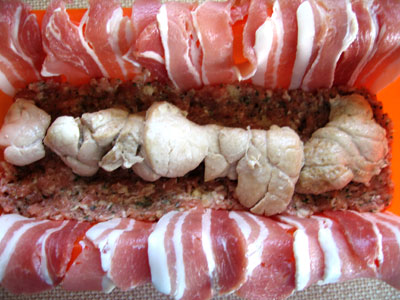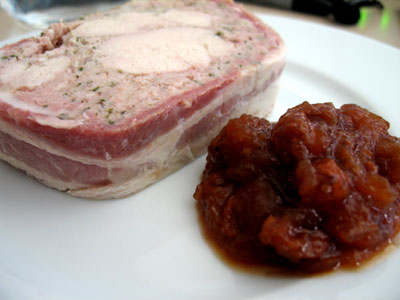I have a theory about cookbooks, that publishers deliberately insert mistakes into the copy in order to give themselves ammunition in the battle against counterfeiters. Sir! I accuse you of ripping off my recipe for apple strudel! Only an imbecile would have followed my directions and used gravel in place of lemon zest! Your honour, I rest my case! And so on.
A perfect example is the case of Antony Bourdain’s recipe for clafoutis, in which temperature and oven-time directions are suggested that would make a pyromaniac blanch. More evidence for this theory can be found on page 455 of Hugh Fearnley’s Mammoth Meat Manual, in which our hippy-headed hero claims that 250 grams of minced pork is sufficient when constructing a sweetbread terrine. 250g? Not in my loaf tin, that’s for certain.
Anyway, let’s go back to the beginning. What is a sweetbread? Although it sounds like a delicious treat for children, some kind of wondrous, sugary bun, in reality it’s entirely made of meat, the kind of meat you get on the inside of animals. There are two kinds of sweetbreads, the thymus gland – whose primary function is the production of cells used by the immune system to battle infection – and the pancreas, which secretes the various enzymes that allow the body to break down digestible foods. The precise location of the pancreas is demonstrated by our model below.

The pancreas I managed to procure came not from a female human, sadly, but from a Dutch calf, courtesy once again of the artisan butchers at Kent & Sons, St John’s Wood. Fully aware that these kinds of innards are of a highly perishable nature, I rushed home to examine my freshly-slaughtered bounty. As you can see from the picture below, it’s not nearly as yellow as suggested by the diagram above.

First up, the pancreas is soaked overnight. This removes any traces of blood from the tissue, leaving our mucilaginous friend all pristine and ready for action.
Next, we simmer the pancreas in boiling water for five minutes, which tightens up the flesh and makes the next part of the procedure easier: once the meat has cooled, any cartilage, connective tubes and tougher pieces of membrane are carefully picked off, leaving behind only the finest, most delectable tissue.
And this is where I think Hugh gets it wrong. Lining my rather lovely Le Creuset Silicone Cook ‘n Bake 24cm Rectangular Loaf Mould (bought for me last Christmas by Blogjam reader Alex in America – and don’t forget, kids, I do have a Wishlist) – with slices of streaky bacon and a layer of pork spiced with sage, thyme, salt, pepper and port, I carefully lay the first sweetbread layer down.

If I had taken Hugh’s recommendation to use 250g of minced pork seriously, I’d be struggling right now. In fact, I’d have virtually none of this so-called “forcemeat” left to complete the next layer. Thankfully, however, I’d decided in advance that such a paltry amount wouldn’t be sufficient, and prepared 750g of the stuff. And guess what? It turned out to be precisely the right amount. I swear, someone should give me a cottage and some cows.
After ninety minutes in the oven and a night in the fridge (carefully weighed down by a house brick wrapped in silver foil), my terrine is ready to be turned out. Here’s an aerial photograph:
I cut a slice and serve it up with a spoonful of Mrs Bridges spicy apple chutney. Hugh recommends his broad bean puree but, to be honest, I fear it’s a little bland. Stick to the meat recipes, HFW, that’s what I reckon.

And the taste? Well, it was exquisite; a saliva-inducing symphony of succulence, a tapestry of taste, as it were. And so I took it to work, to share amongst my friends and colleagues.
But virtually no-one wanted any.
Looks divine.
Perhaps Master Hugh’s recipe only works if you raise all the animals for the meat yourself? Certainly 250g of pork from his pigs is worth 750g from any other mere pig .;-}
Your terine looks nice and moist at any rate. Now I know what to do with my silicone molds–looks like your pancreas model knew what to do with silicone as well. . . . However, I may just have to hold out for the animals, river and farm, as well as a Le Creuset Cast Iron Terine mould.
Mmmmm. Looks bloody georgous.. I’ll have some.
Too bad you don’t wrk where I work then. I would have been all over that.
I’ll admit here to being a wimp when it comes to offal. My reaction was: bleurgh!
Also, as far as I know, there is no copyright on recipes.
What do you do for a job ? It ought to be cheffing. That looks really great, well done matey.
Thanks, Mr YS. Coming from a professional like yourself, that’s high praise indeed.
I write content for value-added mobile services for a living (whatever that means), but I have no desire to switch careers at the moment. Chefs are absolute heroes in my eyes, and I’m not sure I could stand the heat.
Yes, I’d eat that – it looks delicious. But I showed the pictures to Mrs Graybo and her reaction was "bleurgh". I suggested that she is happy to eat liver and kidney, so why not pancreas – but got a "you must be joking" response. So why are we squeamish about offal?
I have to say i have the honour of working with fraser and was one of the few who tried the terrine. It was really nice. The pancreas had a weird texture but overall a nice taste. It’s not as good as my mum’s tandoori chicken, but then what is?
Calves’ sweetbreads. My *absolute* favourite – but never cooked at home. Would you mind letting all here present know (a) weight of sweetbreads purchased and (b) cost of same.
Ta.
H
a) 716g
b) A round £20 – the butcher knocked the price down a touch
That is not “Mrs Bridges Spicy Apple Chutney”! You lie. It’s far to dark.
I had a similar problem when I attempted to create Bourdain’s foie gras recipe. His directions called for the liver to be cooked on a searing skillet with no butters or oils. When I placed the meat on the pan all it did was create the culinary equivalent of a smoke bomb. It quickly became a very expensive mistake. Have you made his foie gras yet?
Twenty quid?! Bloody hell. Still, thanks for living the dream for me, Fraser.
pizza.
Fabulous. I guess the bacon adds a lot to the flavour, but I’m wondering whether some kinda glaze wouldn’t work? I don’t really know what that means or if it’s done with terrines, but a tasty, shiny topping would set her off right nice. And how about some chesnuts in among the innards?
I’m well impressed though. Your work colleagues clearly missed out. Talking of work, got any freelance work going at your gaff? One month left out here and I’m on the hunt for UK work. Sohhh… outta touch.
Chrissy: It does look wrong, I agree, but I can assure you’re I’m not making it up. Honest injun.
happystatic: I haven’t, but I will. Fortnum & Masons is having a sale at the moment, and I bought a nice block of foie gras yesterday with a mammoth 75% knocked off the price. Will try Bourdain’s recipe.
pieman: Chestnuts would work, although I like the consistency of texture with this recipe, it’s very smooth. Unlikely on the freelance front (we’re using fewer outside writers these days), but will ask.
Looking truly scruptious there frase, well done on progressing to the sweet breads! I’ve yet to delve into offal as HFW suggests, it’s something that i keep meaning to do but never get around to!
Oh well only another 6-12months until i can lead the life i long for! Should be moving to Londres as well!
We were discussing sweetbreads at work the other day, I knew what they were but one guy insisted they were the ovaries. I set him straight and proclaimed that he was one sick puppy! A little irrelevant as you’re more of a kitten person eh?
Eating pancreas I understand. “Writing content for value-added mobile services” I’m still struggling with as a concept.
That model has discoloured nipples. Mind you, she has had her belly cut open.
What?? Why? I’d eat that, it looks scrummy. I’d probably eat more if you didn’t tell me it was pancreas first, although I know you and I doubt that would be allowed to happen.
*locust flashbacks*
The word for ‘deliberate error introduced into a text or map, often for copyright protection reasons’ is ‘nihilartikel’.
Or is it?
I thought sweetbreads were calves bollocks?!
Live and learn, eh…
Calves’ bollocks are ‘rocky mountain oysters’, or ‘prairie oysters’.
Jelb, I thought the English expression for a deliberate error in a map , for copyright reasons, was a “cartographer’s folly”. . .but now I can find no trace of the phrase online.
I always though that the best sweetbread is made from offals harvested from an overweight Baltimore flutist.
Btw.: have you ever tried calf kindey stew, with some harts and tongs mixed in? It is absolutely sensational. The main thing is the kidneys have to be fresh, cut, with the centerpart removed, and repeatedly soaked in fresh water for 1 day to get the piss out.
Offal makes great meals – but it is probably the most cholesterol-rich kind of food you can have, after egg yolks.
Bit late on the uptake of this one, but although I really shouldn’t let it bother me, quite frankly it pisses me off that your creation is wasted on your current bunch of ungrateful unadventurous colleagues. Next time, either you need me ‘working’ back there (breaking everyone’s computers in the meantime) or give me a shout and I’ll be straight over your side of the square.
i want so much money
I have always been amused at the apparent disgust of offal today, since as recently as the late 19th and early 20th centuries offal was widely used in the UK. I have been eating offal, including pancreas, spleen etc., all my life. The terrine did look good, but one of my favourite presentations was a savoury mille-feuilles layered with sweetbreads in a white sauce/bechamel.